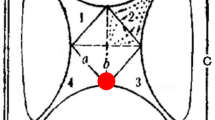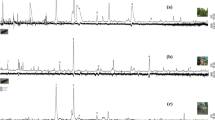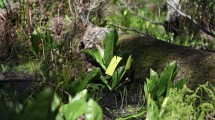Abstract
Xylosandrus compactus is a polyphagus pest that cultivates a symbiotic fungus Fusarium solani in tunnels of host plants for food and is a major threat to coffee production in East Africa. We hypothesized that the female X. compactus, which is the only sex capable of flying to attack its hosts, is attracted to volatiles from F. solani. We investigated responses of females to volatiles released by fungal cultures and bioactive components identified in the fungal volatiles. In Y-tube olfactometer assays, ~68% of females were attracted to volatiles emitted from F. solani over clean air. Bioactive compounds were identified in the fungal volatiles by coupled gas chromatography (GC)/electroantennographic detection (EAD) and GC/mass spectrometric analyses as methyl isovalerate and 2,3-butanediol. We also identified ethanol, a known attractant of X. compactus, using solid phase microextraction captured fungal volatiles analyzed by GC/MS. In field trapping trials, we compared captures of females in plastic bottle traps baited with a range of doses of methyl isovalerate, 2,3-butanediol, and blends of the two compounds, with similar traps baited with solvent only and ethanol. Females were caught by all the baited traps at all the concentrations tested except traps baited with solvent only. Trap captures were however 14–37-fold lower in traps baited with single components and the blends than those baited with ethanol. The possible use of these components as a tool for kairomonal monitoring of populations of X. compactus is discussed.



Similar content being viewed by others
References
Bateman C, Šigut M, Skelton J, Smith KE, Hulcr J (2016) Fungal associates of the Xylosandrus compactus (Coleoptera: curculionidae, Scolytinae) are spatially segregated on the insect body. Environ Entomol 45:883–890. doi:10.1093/ee/nvw070
Brand J, Schultz J, Barras S, Edson L, Payne T, Hedden R (1977) Bark-beetle pheromones: enhancement of Dendroctonus frontalis (Coleoptera: Scolytidae) aggregation pheromone by yeast metabolites in laboratory bioassays. J Chem Ecol 3:657–666. doi:10.1007/BF00988065
Byers JA (1989) Chemical ecology of bark beetles. Experientia 45:271–283. doi:10.1007/BF01951813
Byers JA (1995) Host-tree chemistry affecting colonization in bark beetles. In: Cardé RT, Bell WJ (eds) Chemical ecology of insects. Springer, Berlin, pp 154–213
CABI (2015) Invasive species compendium. http://www.cabi.org. Accessed 11 November 2015
Chénier J, Philogène B (1989) Field responses of certain forest coleoptera to conifer monoterpenes and ethanol. J Chem Ecol 15:1729–1745. doi:10.1007/BF01012261
D’Alessandro M, Turlings TC (2006) Advances and challenges in the identification of volatiles that mediate interactions among plants and arthropods. Analyst 131:24–32. doi:10.1039/B507589K
Davis TS, Crippen TL, Hofstetter RW, Tomberlin JK (2013) Microbial volatile emissions as insect semiochemicals. J Chem Ecol 39:840–859. doi:10.1007/s10886-013-0306-z
Drilling K, Dettner K (2009) Electrophysiological responses of four fungivorous coleoptera to volatiles of Trametes versicolor: implications for host selection. Chemoecology 19:109–115. doi:10.1007/s00049-009-0015-9
Dudley N, Stein JD, Jones T, Gillette N 2006. Semiochemicals provide a deterrent to the black twig borer, Xylosandrus compactus (Coleoptera: Curculionidae, Scolytinae). In: Kirt W, ed. 17th U.S. Department of Agriculture interagency research forum on gypsy moth and other invasive species, 2007, Annapolis: Department of Agriculture, Forest Service, pp 34
Egonyu JP, Kucel P, Kangire A, Sewaya F, Nkugwa C (2009) Impact of the black twig borer on robusta coffee in Mukono and Kayunga districts, central Uganda. J Anim Plant Sci 3:163–169
Egonyu JP, Mukasa Y, Ogari I, Ahumuza G, Hakiza G, Olal S, Phiri N, Ritchie BJ (2017) Diversity and abundance of twig borers of Robusta coffee and their associated ambrosia fungi in Uganda. Afr Entomol. doi:10.4001/003.025.0000
Fernandes F, Picanço M, Fernandes M, Queiroz R, Xavier V, Martinez H (2012) The effects of nutrients and secondary compounds of Coffea arabica on the behavior and development of Coccus viridis. Environ Entomol 41:333–341. doi:10.1603/EN11003
Flechtmann C, Ottati A, Berisford C (1999) Attraction of ambrosia beetles (Coleoptera: scolytidae) to different tropical pine species in Brazil. Environ Entomol 28:649–658. doi:10.1093/ee/28.4.649
Gandhi KJ, Cognato AI, Lightle DM, Mosley BJ, Nielsen DG, Herms DA (2010) Species composition, seasonal activity, and semiochemical response of native and exotic bark and ambrosia beetles (Coleoptera: curculionidae: Scolytinae) in northeastern Ohio. J Econ Entomol 103:1187–1195. doi:10.1603/EC10026
Greco E, Wright M (2015) Ecology, biology, and management of Xylosandrus compactus (Coleoptera: curculionidae: Scolytinae) with emphasis on coffee in Hawaii. J Integr Pest Manag 6:7. doi:10.1093/jipm/pmv007
Hanula JL, Mayfield AE, Fraedrich SW, Rabaglia RJ (2008) Biology and host associations of redbay ambrosia beetle (Coleoptera: curculionidae: Scolytinae), exotic vector of laurel wilt killing redbay trees in the southeastern United States. J Econ Entomol 101:1276–1286. doi:10.1603/0022-0493
Harrington T, Aghayeva D, Fraedrich S (2010) New combinations in Raffaelea, Ambrosiella, and Hyalorhinocladiella, and four new species from the redbay ambrosia beetle, Xyleborus glabratus. Mycotaxon 111:337–361. doi:10.5248/111.337
Holighaus G (2012). Odour signals relevant to beetles in deadwood habitats. Dissertation, Georg-August-Universität Göttingen
Holighaus G, Weißbecker B, von Fragstein M, Schütz S (2014) Ubiquitous eight-carbon volatiles of fungi are infochemicals for a specialist fungivore. Chemoecology 24:57–66. doi:10.1007/s00049-014-0151-8
Hulcr J, Mann R, Stelinski L (2011) The scent of a partner: ambrosia beetles are attracted to volatiles from their fungal symbionts. J Chem Ecol 37:1374–1377. doi:10.1007/s10886-011-0046-x
InterAfrican Coffee Organization (2013) Report and decisions of the 53rd annual general assembly of the InterAfrican Coffee Organization. http://www.iaco-oiac.org/sites/default/files/report_and_decisions_aga_53_2.pdf. Accessed 27 November 2013
International Coffee Organisation (2014) Report on the critical situation in East and Central Africa caused by black coffee twig borer (BCTB): case of Uganda. http://www.ico.org/documents/cy2013-14/ed-2176e-report-twig-borer.pdf. Accessed 31 January 2014
Jaramillo J, Torto B, Mwenda D, Troeger A, Borgemeister C, Poehling H-M, Francke W (2013) Coffee berry borer joins bark beetles in coffee klatch. PLoS ONE 8:e74277. doi:10.1371/journal.pone.0074277
Jeleń HH (2003) Use of solid phase microextraction (SPME) for profiling fungal volatile metabolites. Lett Appl Microbiol 36:263–267. doi:10.1046/j.1472-765X.2003.01305.x
Johnston A, Booth C (1983) Plant pathologist’s pocketbook. Commonwealth Agricultural Bureaux, Wallingford
Jong SC, Birmingham JM (1993) Mushrooms as a source of natural flavor and aroma compounds. In: Chang ST, Buswell JA, Chiu SW (eds) Mushroom biology and mushroom products, proceeding of the first international conference. The Chinese University of Hong Kong, Hong Kong, pp 345–366
Kagezi H, Kucel P, Egonyu J, Nakibuule L, Kobusingye J, Ahumuza G, Matovu R, Nakendo S 2013. Impact of the black coffee twig borer and farmers’ coping mechanisms in Uganda. African Crop Science Conference Proceedings, 13–17, October 2013, Entebbe, Uganda. pp 285–292
Kagezi G, Kucel P, Egonyu J, Kyamanywa S, Karungi J, Pinard F, Jaramillo J, van Asten P, Wagoire W, Ngabirano H (2014) A review of the pest status and research progress on the black coffee twig borer, Xylosandrus compactus (Eichhoff) in Uganda. 25th International Conference on Coffee Science (ASIC), 8–13 September 2014 Armenia, Colombia. pp 42-52
Kanchiswamy CN, Malnoy M, Maffei ME (2015) Chemical diversity of microbial volatiles and their potential for plant growth and productivity. Front Plant Sci. doi:10.3389/fpls.2015.00151
Kelsey RG, Beh MM, Shaw DC, Manter DK (2013) Ethanol attracts scolytid beetles to Phytophthora ramorum cankers on coast live oak. J Chem Ecol 39:494–506. doi:10.1007/s10886-013-0271-6
Kirkendall L (1983) The evolution of mating systems in bark and ambrosia beetles (Coleoptera: scolytidae and Platypodidae). Zool J Linn Soc 77:293–352. doi:10.1111/j.1096-3642.1983.tb00858.x
Kirkendall LR, Biedermann PHW, Jordal BH (2015) Evolution and diversity of bark and ambrosia beetles. In: Vega FE, Hofstetter RW (eds) Bark beetles: biology and ecology of native and invasive species. Academic Press, Cambridge, pp 85–156
Knoblauch K, Maloney LT (2012) Modeling Psychophysical Data in R. Springer, Berlin
Koschier EH, De Kogel WJ, Visser JH (2000) Assessing the attractiveness of volatile plant compounds to western flower thrips Frankliniella occidentalis. J Chem Ecol 26:2643–2655. doi:10.1023/A:1026470122171
Kuhns EH, Tribuiani Y, Martini X, Meyer WL, Peña J, Hulcr J, Stelinski LL (2014) Volatiles from the symbiotic fungus Raffaelea lauricola are synergistic with manuka lures for increased capture of the redbay ambrosia beetle Xyleborus glabratus. Agric For Entomol 16:87–94. doi:10.1111/afe.12037
Luna E, Cranshaw W, Tisserat N (2014) Attraction of Walnut Twig Beetle Pityophthorus juglandis (Coleoptera: curculionidae) to the fungus Geosmithia morbida. Plant Health Prog 15:135. doi:10.1094/PHP-RS-14-0001
Magalhães S, Guedes R, Demuner A, Lima E (2008) Effect of coffee alkaloids and phenolics on egg-laying by the coffee leaf miner Leucoptera coffeella. Bull Entomol Res 98:483–489. doi:10.1017/S0007485308005804
Magalhães ST, Fernandes FL, Demuner AJ, Picanço MC, Guedes RNC (2010) Leaf alkaloids, phenolics, and coffee resistance to the leaf miner Leucoptera coffeella (Lepidoptera: lyonetiidae). J Econ Entomol 103:1438–1443. doi:10.1603/EC09362
Miller DR, Asaro C (2005) Ipsenol and ipsdienol attract Monochamus titillator (Coleoptera: cerambycidae) and associated large pine woodborers in southeastern United States. J Econ Entomol 98:2033–2040. doi:10.1603/0022-0493-98.6.2033
Miller DR, Duerr DA (2008) Comparison of arboreal beetle catches in wet and dry collection cups with Lindgren multiple funnel traps. J Econ Entomol 101:107–113. doi:10.1603/0022-0493
Miller DR, Rabaglia RJ (2009) Ethanol and (−)-α-pinene: attractant kairomones for bark and ambrosia beetles in the southeastern US. J Chem Ecol 35:435–448. doi:10.1007/s10886-009-9613-9
Miller DR, Asaro C, Crowe CM, Duerr DA (2011) Bark beetle pheromones and pine volatiles: attractant kairomone lure blend for longhorn beetles (Cerambycidae) in pine stands of the southeastern United States. J Econ Entomol 104:1245–1257. doi:10.1603/EC11051
National Institute of Standards and Technology (NIST) (2011) NIST/EPA/NIH mass spectral library. http://www.nist.gov. Accessed 6 March 2017
Ngoan N, Wilkinson R, Short D, Moses C, Mangold J (1976) Biology of an introduced ambrosia beetle, Xylosandrus compactus, in Florida. Ann Entomol Soc Am 69:872–876. doi:10.1093/aesa/69.5.872
Njihia TN, Jaramillo J, Murungi L, Mwenda D, Orindi B, Poehling H-M, Torto B (2014) Spiroacetals in the colonization behaviour of the coffee berry borer: a ‘push-pull’ system. PLoS ONE 9:e111316. doi:10.1371/journal.pone.0111316
Nout M, Bartelt R (1998) Attraction of a flying nitidulid (Carpophilus humeralis) to volatiles produced by yeasts grown on sweet corn and a corn-based medium. J Chem Ecol 24:1217–1239. doi:10.1023/A:1022451020013
Paine TD, Raffa KF, Harrington TC (1997) Interactions among scolytid bark beetles, their associated fungi, and live host conifers. Annu Rev Entomol 42:179–206. doi:10.1146/annurev.ento.42.1.179
Phelan PL, Lin H (1991) Chemical characterization of fruit and fungal volatiles attractive to dried-fruit beetle, Carpophilus hemipterus (L.) (Coleoptera: nitidulidae). J Chem Ecol 17:1253–1272. doi:10.1007/BF01402948
R Development Core Team (2015) R: A language and environment for statistical computing. R Foundation for Statistical Computing, Vienna, Austria. URL https://www.R-project.org/. Accessed 19 December 2015
Robert PA (1995) Identification of essential oil components by gas chromatography/mass spectroscopy. Allured Publishing Corporation, Carol Stream
Schroeder L, Lindelöw Å (1989) Attraction of scolytids and associated beetles by different absolute amounts and proportions of α-pinene and ethanol. J Chem Ecol 15:807–817. doi:10.1007/BF01015179
Six DL (2012) Ecological and evolutionary determinants of bark beetle—fungus symbioses. Insects 3:339–366. doi:10.3390/insects3010339
Steinemann A (2004) Human exposure, health hazards, and environmental regulations. Environ Impact Assess Rev 24:695–710. doi:10.1016/j.eiar.2004.06.002
Verginer M, Leitner E, Berg G (2010) Production of volatile metabolites by grape-associated microorganisms. J Agric Food Chem 58:8344–8350. doi:10.1021/jf100393w
Wood DL (1982) The role of pheromones, kairomones, and allomones in the host selection and colonization behavior of bark beetles. Annu Rev Entomol 27:411–446. doi:10.1146/annurev.en.27.010182.002211
Zuur A, Ieno EN, Walker N, Saveliev AA, Smith GM (2009) Mixed effects models and extensions in ecology with R. Springer, Berlin
Acknowledgements
We thank Hillary Kirwa and Onesmus Wanyama for technical assistance at icipe; and Rajab Ogogol, Isaac Okiring, and Isaac Ogari for laboratory and field assistance at the National Coffee Research Institute (NaCORI), Mukono, Uganda. We are grateful for administrative support from the leadership and staff of icipe and NaCORI, where the studies were conducted. A post-doctoral fellowship to the first author to undertake this research was obtained from the German Academic Exchange Service (Code Number: A/13/93772) through icipe’s Capacity Building and Institutional Development programme, for which we are grateful. We also appreciate the anonymous reviewers for their critical comments.
Author information
Authors and Affiliations
Corresponding author
Ethics declarations
Conflict of interest
The authors declare that they have no conflict of interest.
Additional information
Communicated by Jarmo Holopainen.
Rights and permissions
About this article
Cite this article
Egonyu, J.P., Torto, B. Responses of the ambrosia beetle Xylosandrus compactus (Coleoptera: Curculionidea: Scolytinae) to volatile constituents of its symbiotic fungus Fusarium solani (Hypocreales: Nectriaceae). Arthropod-Plant Interactions 12, 9–20 (2018). https://doi.org/10.1007/s11829-017-9552-2
Received:
Accepted:
Published:
Issue Date:
DOI: https://doi.org/10.1007/s11829-017-9552-2




